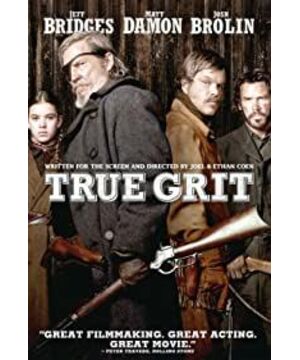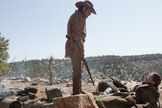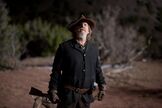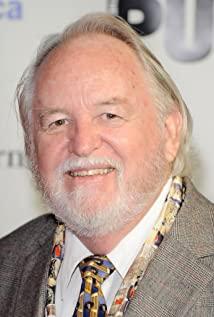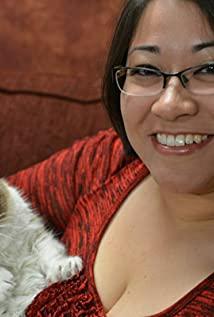Someone once asked that Spaghetti Westerns are pretty hairy and beautiful-it takes a long time to talk about a little bit of shit.
You don’t know what “desolate” means, just to have the taste, not only the scenery in the picture, but also the one person and one horse in the scene. In Morricone’s strange but never lively soundtrack, they are heading towards destiny. This layer consists of space. The extension of the sense of time reflects the barrenness of the sense of time. Try to see how a single horse walks for half a day in a place where "the desert is still desert after the desert, and the grass is still grass behind".
Even if it’s a mess, you can’t rush, you have to be leisurely, but where the stars are where the wind is blowing, the storm that should come is coming, and the pedestrians who should go are going, whether you are rushing or slow, impartial. So he could only watch the star facing the wind steadily, and push the storm past. In this endless piece, there is always a lot of time to spend on a mess. In the end, no matter loneliness or legend, it accounts for at least two elements that I like-simplicity and style.
Because I like westerns, I originally wanted to find a better mental state. At least I started the article when the paste in my brain was lighter. I even planned to give it to westerns, Chinese martial arts films, kung fu films, Japanese swordsman films, and sword halberds. The film is a horizontal analysis and comparison of the generations. But seeing this development is inevitable in the short term, I’m afraid I’ll forget it if I don’t talk about it. As for this "world chivalrous view of a general" plan, I don’t know that I can’t download it, and I have information to check. Not a film major, this is not writing a graduation thesis, so why bother with it. So I just spit out briefly.
This movie is adapted from the novel of the same name. This novel was put on the big screen in the 1960s and got the actor's Golden Man. Now this edition is directed by the Coen brothers. So there are three viewing angles: one is movies adapted from literary works, the second is movies remade from classic old works, and the third is movies that embody modern Western style.
The original work of this novel is a story that the heroine reminisces about when she was 14 years old in the first person, so after reading it through, there are several distinct feelings:
One is that the heroine’s narrative has a clear sense of withdrawal. As the person involved, regarding the death of her father and the danger in the process of pursuing the murder, due to the passing of the incident and due to her personality, she has an attitude of "being out of the world" and does not do anything. Too many emotional vents; the
second is that the author Charles Portis quoted important figures of the time and asked the heroine to repeatedly confess her religious views, and emphasized the story and the era of the characters in the story. Sense and regional color. Even the cat of the Chinese grocery store owner is named after the General of the Confederate Union during the Civil War.
The third is the characterization of the character-this is a trick in the first-person novel. The author makes Mattie leave the reader with the impression of "pragmatic, stubborn, brave and straightforward", but in this way, Mattie is bound to not be too psychological in the novel. Self-analysis of activities would seem too kind, and a fourteen-year-old girl, no matter how smart and capable she is, as the daughter of a farmer, after all, she is innocent and the world view of right and wrong is far less complicated than modern people, and she cannot treat others like an adult. The psychological activities and behavioral patterns of the students are too in-depth analysis. Therefore, most of the characters in the book are written in line drawing through the observation of a fourteen-year-old girl (although it is a memory, the impression of these characters is always what she got when she was fourteen). The personality of the heroine is revealed by her narrative tone, evaluation of others and interpretation of her own behavior.
Fourth, a sense of cold humor often emerges from some lace news-like details. For example, Mattie recalled that the novel she read during her illness was about a rich lady. She did not need to work or do housework, the only thing that needed to be upset. I just don't know who should be the husband-in-law before a rich gentleman who has a lot of dogs and a pastor-of course, both of them love her to death. Then Mattie commented, "This naturally arouses people's interest. I am very happy. I remember that the woman only discovered after marriage that the person she chose was not good. But I forgot who she chose."
The combination of these factors makes the process of reading a novel feel very much like listening to the words of an aunt who has a strong mind and a clear vision of the Western era. It is a legend, and it is not as unbelievable as a fairy tale. The characters and digressions brought out by her words from the Middle East make the legend more realistic and make the characters inside more vivid. You can even hear her feelings for LaBoef's girls from her tone of voice-if you have enough imagination.
From this perspective, although neither version has made any major changes in the general plot of the story, in fact, the temperament of this version is closer to the original.
I almost forgot about this version in the 60s. After quickly recalling it with the help of pps, there is nothing wrong with firming my impression-this is a children's western movie. Because of the different shooting purposes, the details are very different.
In that era, adding narration to westerns was not popular, so the story started completely sequentially. This part is definitely a waste of time and film. For the same amount of time, the new version uses narration to not only explain the incident in a few words, but also use comments to reveal the character of the father, the relationship with Chaney, the reason for going to Fort Simth and other backgrounds. , Quickly justified his subsequent revenge behavior, and almost completely copied the original sentence with the novel, from the tone of the narrative, the heroine's precociousness and determination are immediately revealed. If you want to achieve the same effect without narration, the old version needs to pave the way for the "Father Is Killed" section that can only be regarded as the "prologue", but limited to the movie time, it feels a bit "deliberate".
In order to highlight the fairytale temperament of "the little girl took the tin man and the scarecrow to oz country to take a risk and avenged her father", the old version of Mattie was set as an impatient tomboy. There are two particularly obvious scenes. One is that she complains to her mother about Chaney in the prologue, and the other is that she blatantly complains about poor food at the dining table in the dormitory. Originally, the screenwriter might just want to strengthen her "childishness" and "intelligence", but she tried too hard, and it seemed that the little girl was innocent and rude. Mattie in the original work is not such a "little clever", but a calm and pragmatic. She also feels that the food is not good, but she feels that she can go well. She is dissatisfied with sharing a room with others, but she thinks, "Who is going to fight at this time? It’s no good either.” So she endured it. It can be said that she is not the aggressive type in the face of non-principle issues-this is her childlike temperament.
If the story time is set in autumn instead of the winter described in the book, and the main plot is arranged in the daytime, it is subject to technical conditions. In the old version, Mattie’s short hair, short jacket and always bright dress must be Deliberately. The purpose is nothing more than to make her look lively and have a boyish personality-of course this is against the original. It’s hard to say whether Mattie’s styling in the new version refers to Christina Ricci in "Adam’s Family" (but Ricci of the same age must be asked to play this role...it’s very weird, and it can be developed into a supernatural movie. ), she is always dark, and the shoulder pads on her jacket are so big that she is almost out of proportion to her figure, showing that she has the traits of an adult man.
As for the cold humor in the original work, fairy tale films are naturally not needed. The new version cleverly captures these points (for example, the Irishman said, "If you want to kiss your dad, it's okay"), and use the expansion cherished and importantly (in the new version, he specifically asked him to say it twice).
Of course, the biggest difference lies in the ending. In the old version, after the legendary duel, the story was finally fixed on the heroic posture of John Wayne Prancing Horse, completing the standard Western film format-the good guys kill the bad guys, the heroes kill the dogs. But in the new version, the ending is much more complicated. And this paragraph is not the "end" in the movie-that is, after the story has ended, explain the subsequent added value of each person. If you compare the treatment of the two editions in the "hanging" scene, it is obviously the "center." Thought determines content".
In the original work, the last words of the three hanging prisoners are detailed. One of them said, "I killed the wrong person, or I will end up here if I don't believe it." This is a consciously unfair unwillingness, and the Indian said " There is nothing to say. I believe in the Lord and have eternal life." It is the spirit of seeing death as home. The third long talk is "Educate the children well, or they will become like me". It is too late to regret. It seems that this paragraph was cut in the old version, and it is a matter of hanging people directly. In the new version, the Indian section is removed because it is a purely religious testimony (the heroine is limited to her birth environment, age, background, religious beliefs and age at the time, and I commented a lot on this. The new version obviously does not want to entangle the heroine’s religion), but Keeping the words of the other two prisoners completely, this "subsection", which has nothing to do with the main plot, takes up the time of the movie so well (the testimony of educating the child is very long), it must be a deliberate move.
"Old Nowhere" is a story about the evil in human nature. The killer asked the cowboy wife to guess the coin and said "I have no choice", and the cowboy wife said "You have it", but he didn't. Obviously, the Coen brothers did not intend to treat this movie as a genre film that "the little girl avenged her father's brave murder and arson is worthy of praise"-the original intent of Zhenghe's novel.
A fourteen-year-old girl tirelessly followed the two rough old men who licked blood and went deep into the Indian reservation to chase down a group of notorious robbers in order to "want to see Chaney hanged." Maybe from the local point of view at the time. As it should be (the author of the original novel made the heroine maintain this "as it should" attitude), but from a modern point of view, it can be regarded as cold. "Want to see or even contribute to the death of others" is a malicious, bloodthirsty nature in human nature. This nature is a snake in hibernation. Once awakened and lured out, it will become as instinctively chasing like Cogburn. Compared with the old works full of warm colors and beautiful scenery, the new version strongly highlights the bleak and cold environment, just like human beings in this nature. Perhaps this is our natural part, the unselectable part, the real part. .
LaBoeuf is a very interesting character. This surname is full of slots—it’s a French word meaning "beef". I don’t know who first thought of using this as a surname (it happens to be a surname in Hollywood right now). His surname was pronounced like "LeBeef"-it is common sense for Americans to pronounce terrible foreign languages, but he can't even tell his surname, coupled with his gimmicky dress as a Texas cowboy in Hong Kong, well-managed appearance, arrogant The demeanor (the two versions on this floor were not performed), it can be regarded as the unique scenery of that era. I always think that between the lines of the book, Mattie has a special affection for this little patrol who wants to climb up.
The image of LaBoeuf is the image we are used to in old western movies, the representative image of the western spirit, and the iconic image of that era. Mattie said at the end that he hoped to get news from LaBoeuf, it was his hope for "the cowboy is not dead", and the memory of the age that is far away. When the pure white snow fell, the girl could use blood to pay the blood debt. Taken for granted and proud of the age.
PS: I'm desperate for what I coded under my mental illness
View more about True Grit reviews


